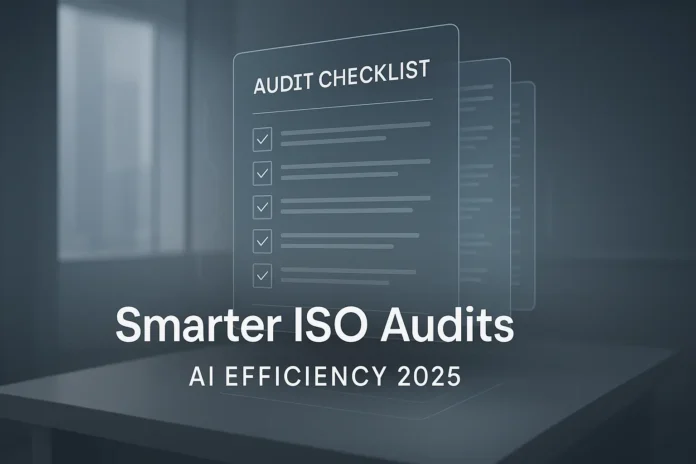Interior design firms increasingly rely on AI marketing tools, with 72% anticipating that artificial intelligence will manage complex planning tasks by 2025. The most effective approach combines visual generation tools like Midjourney, CRM automation through HubSpot, and social scheduling via Later to deliver measurable increases in client bookings.
Who Needs AI Marketing Tools for Interior Design Businesses?
US-based interior designers, boutique studios, and design professionals with 1-20 staff benefit most from AI marketing automation. Solo practitioners and small firms gain immediate advantages through accelerated content creation, automated lead qualification, and streamlined client communications without expanding headcount.
Small design studios face persistent challenges around limited budgets, time scarcity, and the demand for professional-quality marketing assets. Traditional approaches require dedicated marketing staff or costly agency retainers.
AI tools eliminate these barriers by automating visual content generation, lead nurturing workflows, and social media management at accessible price points.
The global AI in interior design market is projected to reach $3.59 billion by 2029, growing at a 26.9% annual rate, demonstrating widespread industry adoption.
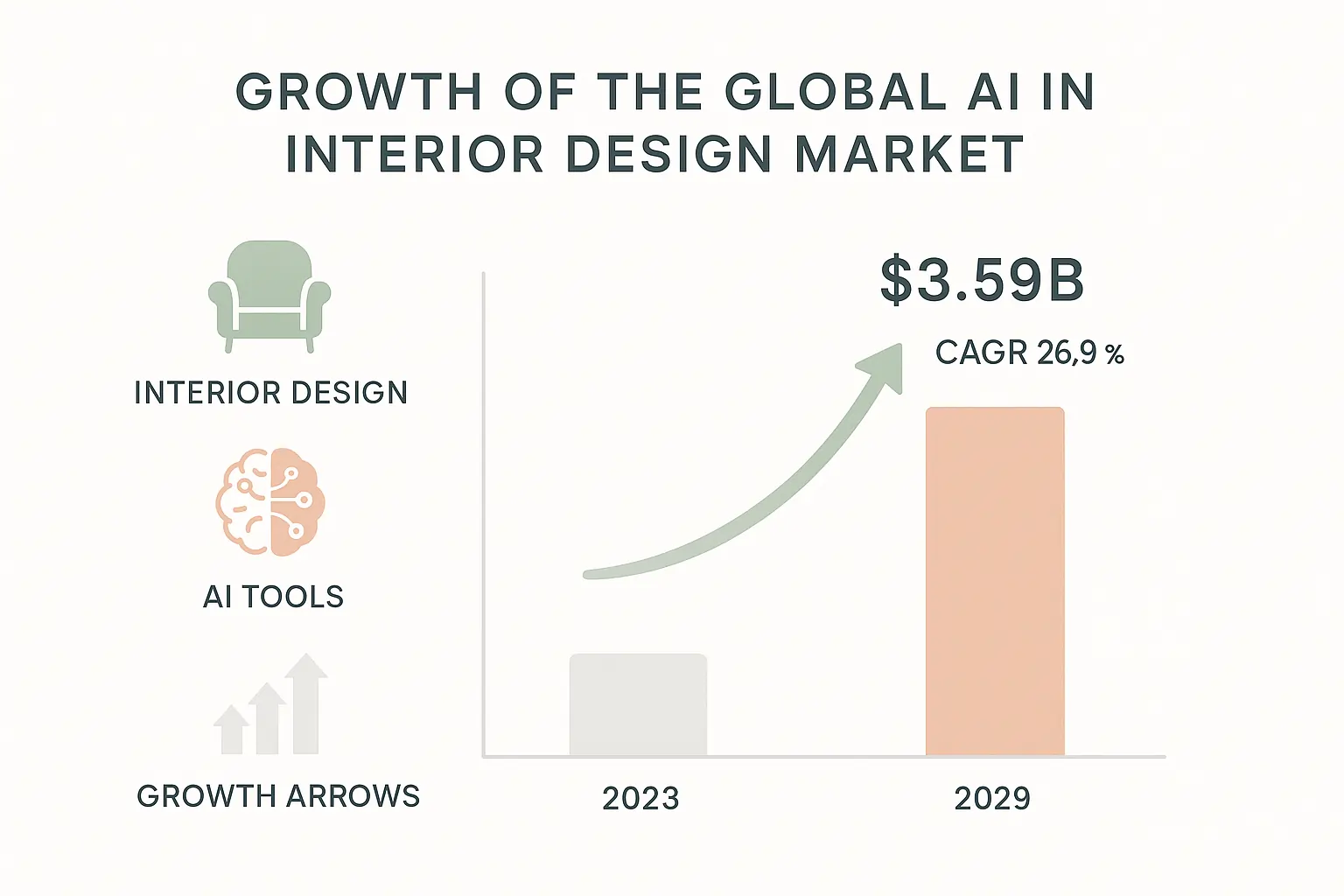
A kitchen design studio in Austin increased Instagram engagement by 340% by using RoomGPT for photo transformations, combined with Canva AI for branded graphics, and converted 23% more inquiries into paid consultations.
The technology stack selection depends on business size and marketing maturity. Starter firms begin with basic automation, while established practices implement comprehensive AI tools across visual creation, customer relationship management, and social distribution channels.
What are the essential AI marketing tool categories?
Visual creation, CRM automation, social scheduling, and chat automation form the foundational AI marketing infrastructure. Midjourney generates concept renderings, HubSpot manages lead pipelines, Later automates posting schedules, and ManyChat converts Instagram DMs into consultation bookings.
Visual Content Generation Tools
Midjourney: Premium AI rendering for mood boards and concept presentations. Subscription plans range $10 to $60 monthly. Commercial usage rights are included for paid tiers. Delivers superior artistic quality but requires prompt engineering skills.
Adobe Firefly: Commercial-safe image generation with complete licensing clarity. Monthly costs range from $23 to $ 53, depending on feature requirements. Integrates directly with Adobe Creative Suite workflows. Provides legal safety for client-facing deliverables.
Canva AI: Branded social graphics with template integration. Pricing starts $15 monthly for individuals and $40 for teams. Exports optimized for Instagram, Pinterest, and Facebook specifications. Best for consistent brand representation across platforms.
RoomGPT: Photo-to-styled room transformations. A free tier is available, with premium features costing $29 per month. Processes client space photos into multiple design style variations within minutes. Ideal for quickly exploring concepts with prospects.
Planner 5D: AR room preview capabilities. Subscription costs $20 per month based on features. Generates 3D visualizations that the user views through augmented reality. Reduces revision cycles through improved pre-construction visualization.
CRM and Email Automation Platforms
HubSpot: Complete pipeline management with native Instagram integration. Entry plans start at $45 per month for small teams. Advanced automation includes lead scoring, email sequences, and form integration with Meta lead ads. Handles 200+ monthly inquiries efficiently.
Mailchimp: Email-focused automation with landing page builders. Starts $10 monthly for growing contact lists. Simpler interface suited for straightforward nurture campaigns. Limited CRM depth compared to enterprise alternatives.
Zoho CRM: Budget-friendly automation with multi-channel capabilities. Costs $14-$ 45 per user per month. Custom workflow rules, email and SMS features, and third-party integrations. Strong value proposition for cost-conscious firms.
Salesforce Einstein: Enterprise-grade predictive scoring and analytics. Higher investment at $ 75-$150+ per user per month. Advanced forecasting, custom reporting, and API capabilities. Suitable for firms managing high-value commercial projects.
A boutique residential firm in Denver implemented HubSpot, along with Adobe Firefly and Planner 5D, resulting in a 20% reduction in cost-per-lead and a 25% increase in proposal acceptance rates. The integrated approach directly connects social discovery to automated nurturing sequences, eliminating manual handoffs.
Automated emails deliver 52% higher open rates, 332% more clicks, and 2,361% better conversion rates compared to manual campaigns, making CRM automation essential for interior designers seeking scalable growth.
How do you build a 30-minute AI lead funnel?
Create Instagram lead magnets, automate DM responses, sync to CRM pipelines, qualify with design questionnaires, and trigger nurture sequences. The complete setup requires 30 minutes, but it generates qualified leads continuously without requiring ongoing manual intervention.
Five-Step Funnel Implementation
Step 1: Configure Instagram Lead Form and Auto-Reply to Offer Meta lead ads with style guides or room planning templates. Integrate ManyChat for instant DM responses. Set up automated qualifying questions about project type, budget range, and timeline.
Step 2: CRM Pipeline Sync
Automatically connect Instagram leads to HubSpot or Mailchimp. Tag contacts by project category (residential/commercial), budget tier, and urgency level. Segment lists for personalized follow-up sequences.
Step 3: Design Questionnaire Automation Auto-send brief questionnaires covering budget parameters, aesthetic preferences, project scope, and decision timeline. This qualification filters serious prospects from casual browsers. Responses trigger appropriate nurture tracks.
Step 4: Booking Integration Qualified leads receive Calendly links for consultation scheduling. ManyChat manages the complete flow without staff involvement. Calendar integration prevents double-bookings and sends automated reminders.
Step 5: Nurture Sequence Activation Trigger three-email sequences featuring case studies, AI-generated room concepts matching stated preferences, and social proof elements. Sequences adapt based on engagement behaviours and responses to the questionnaire.
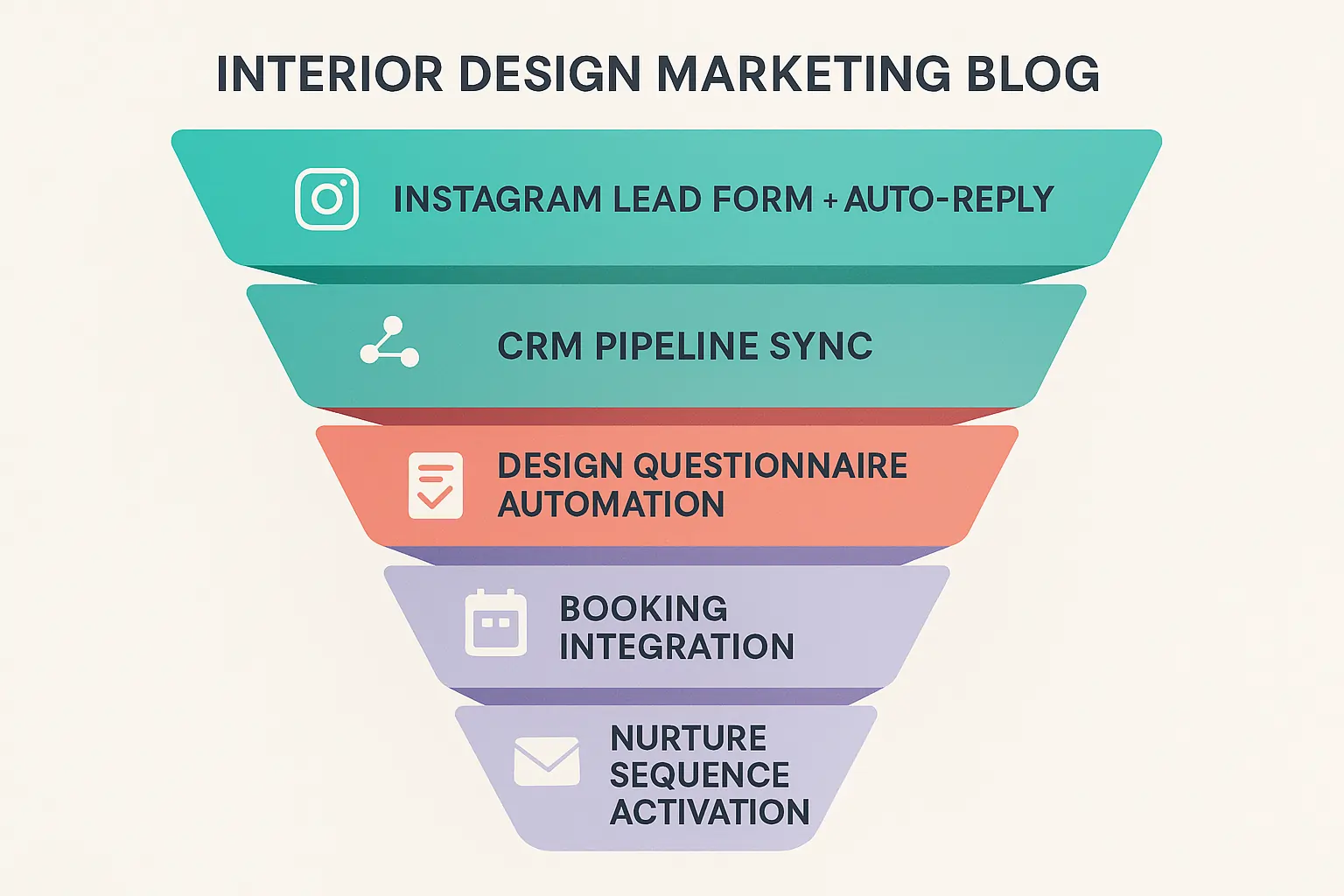
A residential design firm in Portland implemented this exact workflow, resulting in a 45% increase in consultation bookings while reducing manual lead handling time by 80%. Their system processes 340+ leads monthly with minimal team involvement. The AI integration approach freed design staff to focus on billable client work rather than administrative follow-up.
Which visual creation platform delivers maximum ROI?
Midjourney offers superior artistic quality for concept development, Adobe Firefly provides commercial-safe licensing for client deliverables, RoomGPT excels at rapid photo transformations, and Canva AI efficiently handles branded social content. Platform selection depends on the primary use case and budget parameters.
Platform Comparison
| Platform | Primary Use | Monthly Cost | Key Advantage | Commercial Rights |
|---|---|---|---|---|
| Midjourney | Concept art, mood boards | $10-60 | Artistic quality | Paid subscribers |
| Adobe Firefly | Client presentations | $23-53 | Legal safety | Full commercial |
| RoomGPT | Photo transformations | $0-29 | Speed, simplicity | Limited free |
| Canva AI | Social graphics | $15-40 | Brand consistency | Full commercial |
| Planner 5D | AR previews | $20-50 | Client visualization | Commercial use |
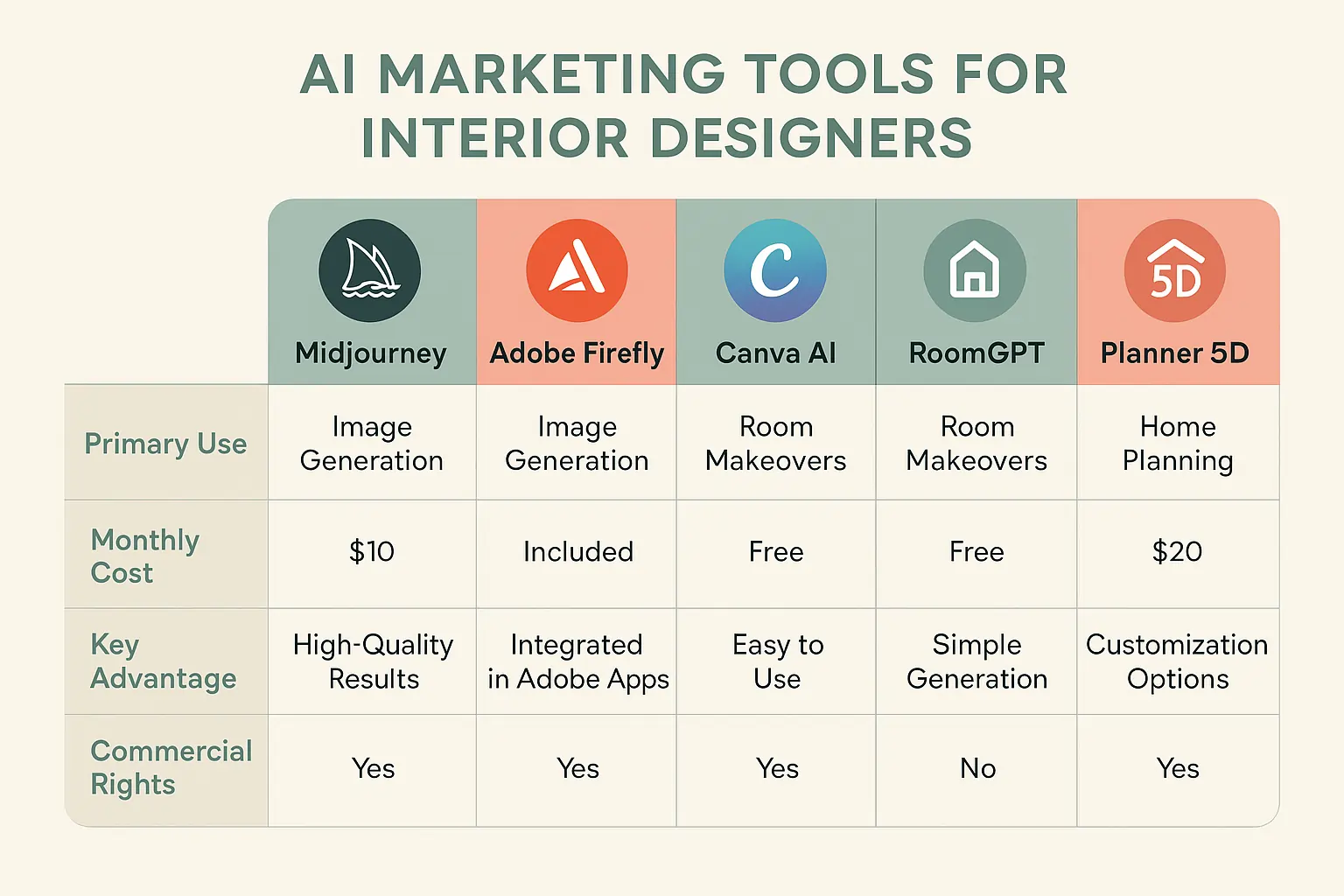
Implementation Strategy: A high-end residential designer in Miami uses Midjourney for initial concept exploration, then transfers promising directions to Adobe Firefly for client-facing presentations. This workflow maintains artistic quality while ensuring legal compliance for commercial projects.
The dual-platform approach reduces design development time by 60% compared to traditional methods while meeting the professional standards clients expect from premium design services. The global AI in interior design market is projected to grow at a rate of over 22% annually through 2030, indicating sustained investment in these capabilities.
Professional rendering through AI tools now matches traditional 3Dvisualisationn quality at 90% lower costs and 75% faster turnaround times, fundamentally changing project economics for small firms.
What CRM solution best fits design lead management?
HubSpot excels in pipeline sophistication and Instagram integration, while Mailchimp is well-suited for email-focused workflows. Zoho offers budget-friendly automation, and Salesforce Einstein provides enterprise-level predictive scoring. Selection criteria include business size, lead volume, budget constraints, and technical sophistication requirements.
Platform Selection Framework
HubSpot (Recommended for growth-focused firms):
- Native Meta lead form integration eliminates manual data entry
- Advanced pipeline customization tracks multiple project stages
- Email sequences with design-specific templates and triggers
- Instagram DM sync routes conversations to appropriate team members
- Pricing: $45-120 monthly for teams under 10 users
Mailchimp (Email-first approach):
- Straightforward list management and segmentation
- Landing page builders for lead magnet delivery
- Basic automation workflows for nurture campaigns
- Social media scheduling and basic analytics
- Pricing: $10-35 monthly for growing contact databases
Zoho CRM (Budget-conscious option):
- Multi-channel automation across email, SMS, and social
- Custom workflow rules for design-specific processes
- Third-party integrations via the marketplace
- Mobile app for on-site client management
- Pricing: $14-45 per user monthly
Salesforce Einstein (Enterprise solution):
- Predictive lead scoring based on historical conversion data
- Advanced reporting and custom dashboard creation
- API capabilities for custom integrations
- Project value forecasting and pipeline analytics
- Pricing: $75-150+ per user monthly
A commercial design practice in Chicago implemented HubSpot’s advanced scoring features, completely automating their qualification process. The system scores leads by project value indicators and budget signals, routing high-value prospects to senior designers while nurturing smaller projects through automated sequences.
Approximately 76% of companies now utilize marketing automation, with CRM being a key component of this approach. The Chicago firm’s conversion rate from qualified leads to signed contracts increased from 18% to 34% after implementing AI-powered customer experience optimization workflows.
How do you automate social media effectively?
Generate 3-5 AI concept boards weekly, resize e for platform specifications using Canva AI, schedule e at optimal times with Later, automate DM responses via ManyChat, and analyze performance metrics to identify top content for amplification. This workflow requires 2-3 hours weekly setup, but runs continuously.
Weekly Content Automation Workflow
Monday: Content Generation
- Create 5 room concepts using Midjourney or Firefly
- Focus on trending design styles and seasonal themes
- Generate variations for different project types (kitchen, bath, living spaces)
- Export at high resolution for multi-platform use
Tuesday: Brand Optimisation
- Import concepts to Canva AI for the brand consistency application
- Resize for Instagram posts (1080×1080), stories (1080×1920), Pinterest pins (1000×1500)
- Add branded overlays, logo placements, and call-to-action elements
- Create multiple format versions for A/B testing
Wednesday: Scheduling and Distribution
- Upload to Later with science-backed optimal posting times
- Schedule Pinterest pins for discovery traffic generation
- Set up Instagram story sequences with swipe-up links
- Queue Facebook posts for different audience segments
Ongoing: Automation Activation
- ManyChat handles Instagram DM responses automatically
- Qualifying questions route serious inquiries to the booking system
- Engagement triggers send personalized follow-up sequences
- Analytics track which content drives consultation requests
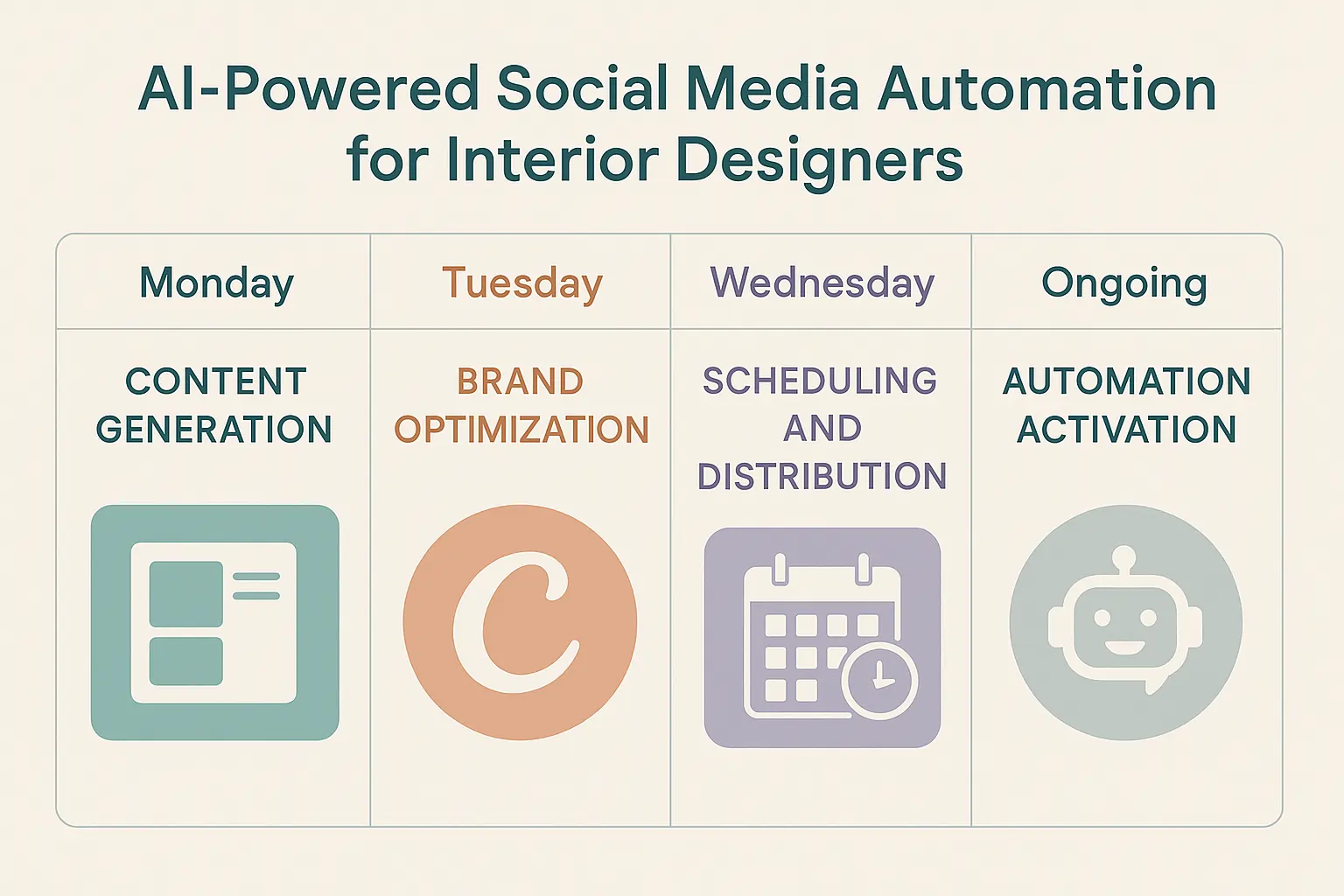
A kitchen and bath specialist in Phoenix implemented this exact workflow, achieving a 340% higher Instagram reach with 67% less manual effort.
Their AI-generated content consistently appears in local design searches, generating 15-20 qualified leads monthly through organic social discovery without paid advertising.
Platform analytics demonstrates that their AI-generated content receives 45% more saves and shares than traditionally created posts. The automation freed 12 hours weekly for actual design work rather than content creation and posting management.
What AI marketing budget makes sense?
Budget-conscious studios start with Mailchimp + Canva AI + ManyChat + Later ($50-80 monthly), established firms use HubSpot + Firefly + Planner 5D + Buffer ($150-250 monthly),
and enterprise practices invest in Salesforce Einstein + Adobe Creative Suite + advanced automation ($400-800 monthly). ROI timelines range from 3 to 12 months, depending on the tier selection.
Three-Tier Investment Model
Starter Stack ($50-80/month):
- Mailchimp: Email automation, landing pages ($10-20)
- Canva AI: Social graphics, tStacktes ($15)
- ManyChat: Instagram DM automation ($15-25)
- Later: Social scheduling, analytics ($15-20)
- Expected ROI: 3-5x investment within 6 months
- Best for: Solo designers, new firms under $100K revenue
Professional Stack Stack-250/month):
- HubSpot: CRM, advanced automation ($45-75)
- Adobe Firefly: Commercial-safe visuals ($23-53)
- RoomGPT: Photo transformations ($29)
- Buffer: Team collaboration features ($35-50)
- Pinterest Ads: Targeted discovery ($20-50 budget)
- Expected ROI: 5-8x investment with higher lead values
- Best for: Established firms $100K-500 revenue
Enterprise Stack ($400-800/month):
- Salesforce Einstein: Predictive analytics ($150-300)
- Adobe Creative Suite: Full workflow integration ($85-130)
- Foyr Neo: Professional 3D rendering ($75-150)
- AdvaStackautomation, custom integrations ($90-220)
- Expected ROI: 8-12x investment for high-value projects
- Best for: Firms $500K+ revenue, commercial focus
A residential design firm in Seattle started with the professional stack. Stackracked $180,000 in attributable new project value within 12 months.
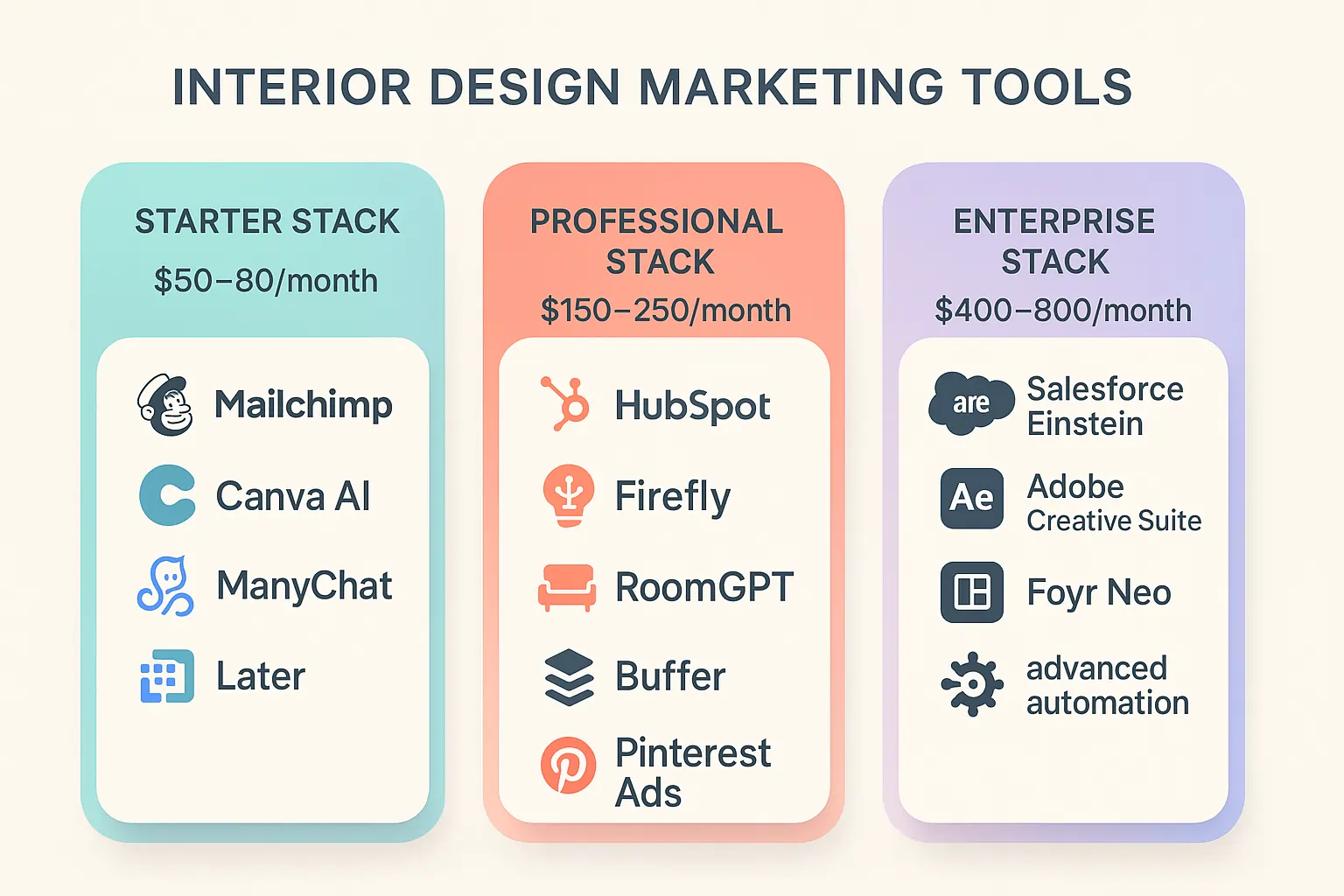
Their cost-per-acquired-customer dropped from $340 to $89 while average project values increased $12,000 through improved targeting and qualification.
Investment recovery typically occurs within 3-4 months, resulting from improved lead quality and conversion optimization. The AI solutions market continues to expand as the competitive advantages of early adopters become increasingly pronounced.
FAQs
What is an AI tool for interior design marketing?
AI marketing tools automate visual content creation, lead qualification, and client communication for interior designers. They utilise machine learning to generate room concepts, manage social media schedules, and nurture prospects through personalised sequences, all without requiring manual intervention.
Can AI generate professional-quality design content?
Modern platforms like Midjourney and Adobe Firefly produce client-ready room concepts and mood boards. Many successful firms use AI for initial concept development and social content, then apply human expertise for technical implementation and client customization.
How much do AI marketing tools cost?
Entry-level stacks start at around $50 per month and typically deliver a 3-5x ROI within six months. Professional setups cost $150-$ 250 per month but generate higher lead values and conversion rates. Enterprise solutions range $400 to $800 monthly for advanced capabilities.
Which platform works best for Instagram marketing?
ManyChat for DM automation, combined with Later for content scheduling, yields optimal Instagram results. Add Canva AI for graphic creation to complete the workflow. This combination typically increases engagement 200-400% compared to manual posting.
Are AI-generated designs accurate for client work?
AI excels in maintaining style consistency and identifying trends, but requires professional oversight for spatial planning and technical specifications. Utilise AI for concept generation and inspiration, while relying on design expertise for implementation and ensuring code compliance.
Can I use AI content for commercial client projects?
Commercial licensing varies by platform. Adobe Firefly provides full commercial rights, Midjourney allows commercial use for paid subscribers, and Canva AI includes business licensing. Always verify the current terms before delivering client work to ensure accuracy.
How long does it take to implement AI marketing?
Setting up a basic funnel typically takes around 30 minutes. Content workflow configuration takes 2-3 hours initially. Most firms see measurable results within 30-60 days as systems optimize and audiences grow through consistent automation.
Strategic Implementation for Interior Design Growth
By 2025, 80% of clients expect some level of AI integration in design projects, making adoption essential for competitive positioning. The most successful firms integrate multiple tools rather than relying on single solutions, creating automated workflows that scale with business growth.
The transformation extends beyond efficiency gains. AI enables small design studios to compete with larger firms through professional-quality visual content and sophisticated marketing automation previously available only to well-funded operations.
Priority Implementation Sequence:
- Start with visual content generation (Midjourney or Adobe Firefly)
- Add CRM automation (HubSpot or Mailchimp, based on budget)
- Integrate social scheduling (Later or Buffer)
- Implement chat automation (ManyChat for Instagram)
- Track performance metrics and optimize based on conversion data
Early adopters maintain significant competitive advantages in the local market; however, the differentiation windows narrow as AI marketing becomes a standard practice. The investment required remains minimal compared to traditional marketing approaches, while potential returns continue to expand.
Success requires the strategic implementation of tools rather than the random adoption of them. Focus on integrated workflows that connect discovery, qualification, and nurturing into seamless client journeys, operating automatically while maintaining personalization.


